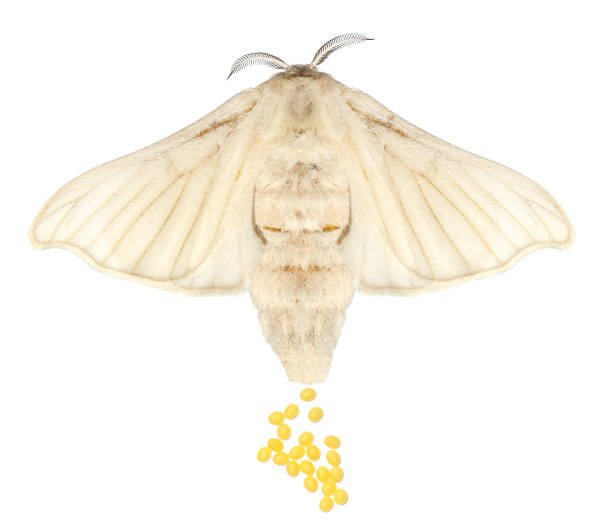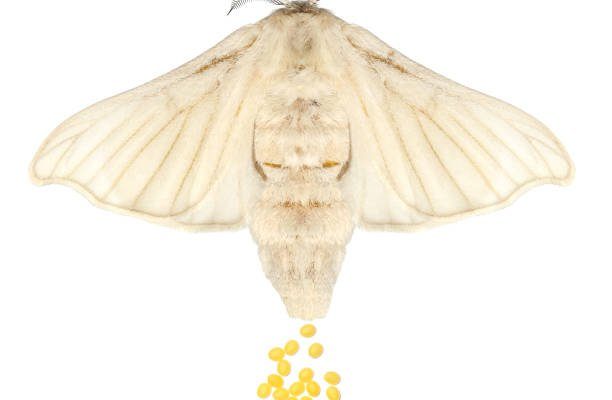
Silkworms, specifically the species *Bombyx mori*, are known primarily for their silk production, but their reproductive behaviors are equally captivating. The way they come together to mate and lay eggs is a well-orchestrated process, much like a performance with its own rhythm and timing. So grab a cup of coffee, and let’s explore this unique aspect of their life cycle!
The Mating Ritual: How Silkworms Connect
Silkworm mating begins with a rather dramatic courtship. Male silkworms are known for their strong sense of smell. They can detect female pheromones from quite a distance. Once he catches a whiff, the male takes off on a mission, fluttering through the air to find the source of the alluring scent. You might imagine him like a lovesick teenager, driven by instinct and a bit of desperation!
When he finally locates a female, the two engage in a courtship dance. This part is quite fascinating! The male flutters around the female, bobbing and weaving as if trying to impress her. If she’s receptive, she’ll accept him. The actual mating process is relatively brief but quite efficient; this rendezvous only lasts about 24 hours. In this time, their bodies synchronize to ensure that the male transfers his sperm effectively.
Despite this brief encounter, it’s packed with excitement and anticipation. This mating ritual ensures genetic diversity in the offspring, giving silkworms a better chance of thriving in their environments.
The Importance of Timing: When Do Silkworms Mate?
You might be wondering: when do silkworms actually mate? The answer isn’t straightforward because it depends on several factors, especially environmental conditions. Most notably, temperature and light play crucial roles in triggering mating behaviors.
In nature, silkworms typically mate during the night. They are nocturnal creatures, so evening hours are their peak time for romance. The cooler temperatures at night and the absence of predators make it safe for them to engage in their mating rituals. But here’s another interesting fact: the female can only mate for a limited period after she emerges from her cocoon. This window generally lasts just a few days. If she doesn’t mate during this time, she’ll miss her chance to reproduce!
This limitation emphasizes the importance of timing in their life cycle. It speaks to the delicate balance that these creatures maintain with their environment. If conditions aren’t right, it can significantly impact their reproductive success.
Silkworm Egg Laying: The Next Step in the Cycle
Once mating has occurred, the female silkworm prepares for one of the most critical aspects of her life: laying eggs. After mating, she’ll lay anywhere from 200 to 500 eggs, often in a single batch! This egg-laying process is vital because it determines the future of the species.
So, how does she do it? After about 24 hours post-mating, the female moves to a suitable location. It’s usually a flat surface, where she lays her eggs carefully. You might think of this like a mother bird building her nest, only silkier! The female releases an adhesive substance from her body which helps the eggs stick together and to the surface, ensuring they stay safe and secure.
Interestingly, the eggs themselves are incredibly resilient. They can withstand varying temperatures and even some humidity, giving them a fighting chance to hatch later. The care that the female takes during this stage is crucial because once she lays her eggs, her job is done. She’s completed her part in the life cycle, and nature takes over from there.
Hatching: The Journey Begins for Silkworms
After laying the eggs, a waiting game begins. The silkworm eggs typically take around 10 to 14 days to hatch, depending on environmental conditions like temperature and humidity. When the hatchlings finally emerge, they’re incredibly small, measuring just about 1-2 millimeters!
This stage is vital for the survival of the species. Immediate access to food—often mulberry leaves—is essential for the young silkworms. They eat almost constantly in their early days to grow and eventually spin cocoons. It’s interesting how the entire cycle hinges on this hatching moment. The young silkworms must be equipped to find food and grow quickly to survive.
Like any fledgling creature, the baby silkworms are a symbol of hope for the future. They carry the genetic legacy of their parents, ensuring that silkworm populations continue despite challenges in their environment.
Environmental Factors Impacting Mating and Egg Laying
Silkworms are incredibly sensitive to their environment, which directly affects their mating and egg-laying behaviors. Changes in temperature and humidity can significantly influence their reproductive success. For example, favorite breeding months often fall in warmer weather. If it’s too cold or humid, the female may not be able to mate effectively or may lay fewer eggs.
This sensitivity can also make them vulnerable to climate change. Higher temperatures may lead to faster cycles, but can also reduce the overall population if conditions become too extreme. The relationship between silkworms and their environment is a delicate one. If we want to ensure their survival, understanding these dynamics is crucial.
You might be surprised at how much we can learn from these little creatures! Their life cycles and behaviors remind us of the interconnectedness of all living things and how each species plays a role in the ecosystem.
Challenges in Silkworm Reproduction
While silkworms seem like they’re thriving, there are several challenges they face when it comes to reproduction. One major issue is diseases and pests that can decimate silkworm populations, affecting their mating opportunities and the overall number of eggs laid.
Additionally, improper rearing conditions can lead to a decline in reproductive success. For instance, if the temperature isn’t right, silkworms may not mate at all. It’s essential for those involved in sericulture (the production of silk) to monitor these conditions closely.
Advancements in technology and practices have helped address some of these challenges, but it’s still a constant effort. By understanding these hurdles, we can better appreciate the efforts made to cultivate silkworms sustainably and effectively.
Silkworm mating behavior and egg laying are more than just biological processes—they’re a spectacle of life. From their dynamic courtship to the moment those tiny eggs are laid, every step is filled with purpose and wonder. These creatures, which produce the silk we cherish, rely on these intricate behaviors to ensure the survival of their species.
Learning about silkworms can give us insight into our own interactions with nature and the impact we have on other forms of life. By observing and understanding their behaviors, we not only appreciate their role in the ecosystem but also inspire ourselves to think more sustainably about the resources we use.
So next time you admire a beautiful silk garment, remember the journey of its origin. It all starts with those charming little silkworms and their remarkable reproductive dance.

